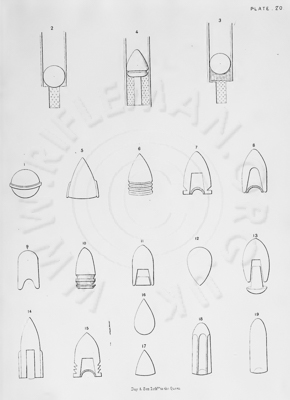The HISTORY of the RIFLE
This comprehensive history of the rifle was written by Colonel E.C. Wilford,
then Assistant-Commandant and Chief Instructor at the famous Hythe School of Musketry in Kent.
(The entire book can be viewed HERE)
The piece was included in his "Class Book for the School of Musketry" published in 1861.
It may be over one hundred and fifty years old, but it is an important historic reference
for anyone who wishes to know more of the early development of the rifled long arm and its projectiles.
HISTORY OF THE RIFLE
We shall now direct our attention to the rifle,—its invention is ascribed to Gaspard. Zollner, of Vienna, towards the end of the fifteenth century. The first society for firing with the arquebuss was founded at Bale, in Switzerland. In the practice of firing at a mark, at Leipsic, 1498, the greater part of the Sharpshooters or Marksmen, were armed with the Rifles. At first, Rifle arms were used only for amusement, and sometimes for the defence of places, but very rarely as weapons of war in the field. Their employment in a campaign only dates from a little before the middle of the seventeenth century.
In 1631, the Landgrave William of Hesse had three companies of Chasseurs, armed with rifles.
In 1645, the Elector Maximilian of Bavaria formed three regiments of Chasseurs, armed with rifles which he intended to employ principally in the minor operations of war. In 1647, Frederick William of Prussia, in his campaign on the Rhine, distributed in each company of infantry, some light infantry and Riflemen.
Frederick the Great, in order to counterbalance the Austrian Light Troops, more particularly the Tyrolese Marksmen, whose fire was exceedingly deadly, felt obliged during the seven years' war to add a company of trained light infantry to the effective strength of each battalion.
In France the Cavalry were supplied with rifles before the Infantry. Towards 1674 Louis XIV. created some squadrons of Cavalry armed with "Carabins ragees." The name was given in France to all arms which were grooved, and it also served for the name of the corps which were first armed with them, viz., " Carabins." In 1680 eight rifle carbines were carried in each troop of English Life Guards. In 1691 the subaltern officers of the Swedish Dragoons received the rifled carabin, and in 1700 those of the Prussian Cavalry received the same rifled arms.
Experiments were tried with rifled small arms in England in the year 1776. We read in the Scots' Magazine, vol. 36, that " the Guards are every day practising the use of the Rifle Gun in Hyde Park. On Saturday, April 27th, 1776, " their Majesties attended a Review of the Rifle-men yesterday, and were much " pleased with the dexterity of the officer, who loaded and fired several times in a minute, and hit the mark each time. He lies upon his back when he discharges his piece."
Austria kept 2000 Sharpshooters, having double carbines, which were supplied with a crotch to rest them upon while shooting. Only one of the barrels was rifled. In 1793 the first model carbine for French Infantry was made at Versailles ; at the same time the model for Cavalry was also fixed. Rifles were soon abandoned in the French Army; they deemed them of more trouble than profit. In 1794 the English adopted the Rifle, which, I fancy, was first used by a Battalion of the 60th, or Royal American Regiment. In 1796 there were in the Austrian Army 15 Battalions of Light Infantry, the greater part of whom were armed with Rifles.
In 1800, Rifles were placed in the hands of the 95th Regiment, now the Rifle Brigade of four Battalions. These Rifles weighed about 10.5 lbs. each, with the sword. They were sighted for 100 and 200 yards, with seven grooves, having a quarter turn in the length of the barrel, which was about 2 feet 6 inches, the length of the Rifle 3 feet 10 inches, weight of sword 11b., diameter of bore .623. The locks were excellent, and had a detent, to prevent the nose of the sear catching at half cock, and it had a bolt, to prevent its going off at half cock. The ball was spherical, and driven in with a mallet, which was afterwards dispensed with, and a greased patch substituted.
During the Peninsular War, our Riflemen were supplied with balls of two sizes, the easiest fitting being designed for use where celerity of loading was required. Baker, who made these Rifles, says in-his Work, 1825, "I have found 200 yards the
greatest range I could fire to any certainty. At 300 yards I have fired very well at " times, when the wind has been calm. At 400 yards, and at 500 yards, I have " frequently fired, and have sometimes struck the object, though I have found it to vary much."
Colonel Dickson, RA., says, "In the early part of the present century, there was "also introduced a rifle-arm for cavalry. The barrel 20 inches, calibre 20 bore, "grooves 7, having the same pitch as those for the infantry; the 7th and 10th light "cavalry were the only regiments armed with them, but they were soon discontinued "from being considered as unfit for cavalry service."
The Brunswick rifle was introduced in 1836. Weight with bayonet 11 lbs. 5oz., length of barrel 2ft. 6-in., bore •704. Two deep spiral grooves with one turn in the length of the barrel. Sighted for 100, 200, and 300 yards. Bullet spherical and belted, diameter .696. Weight of bullet 557 grains. The shooting of this arm was superior to our first rifle, although the loading was not so easy as was desired, and a great disadvantage existed in the bullet and cartridge being separate in the soldier's pouch, the grooves were deeper and rounder than those of the ordinary rifle, the projecting zone of the ball was made to fit the grooves, the ball was wrapped in a linen patch dipped in grease. It was found that, although the rifle loaded easily at first, after constant firing the barrel became very foul, rendering loading nearly as difficult as under the old system of the indented ball. The belt on the ball caused considerable friction while passing through the air. (Plate 20, fig. 1).
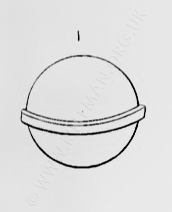
By a committee of officers assembled at Enfield, it was determined that all firing with the Brunswick beyond 400 yards was too wild to give a correct angle of elevation. It was tested at Antwerp in 1844, in an experiment extending to 44,000 rounds, and declared to be the worst tried.
From France chiefly have proceeded most of the modem improvements in fire-arms. The original French rifle (like our own) was loaded by force with a strong ramrod and mallet, and they found that it gave precision with diminution of range. For these reasons during the early campaigns of the French Revolution, the rifle was given up in the French army ; but as their Chasseurs were found to be unequally matched against those of other armies, who surpassed them in accuracy as marksmen, a series of experiments were carried on at different times, with a view to its reintroduction into their service. No satisfactory result was obtained until the occupation of Algeria, when Mons. Delvigne, of the Guarde Royale, took the first step in its restoration. In the flying wars kept up against them by Abd-el-Bader, they found that masses of their men were struck by Arab balls at distances where the French muskets were apparently powerless, and this they afterwards found arose from the long matchlocks of their enemies being fired at a much greater elevation than was ever thought of by European troops. In order to put themselves on an equality with their enemies, Mons. Delvigne showed in 1828 how the rifle bullet could be made to enter the piece easily, and quit it in a forced state; a method. of loading as easy and simple as that of a smooth-bore arm. Expansion was obtained by the introduction of a chamber in the bore, which furnished an annular surface to receive the bullet, and on its being struck a small blow with the rammer it was expanded into the grooves. (Plate 20, fig. 2). 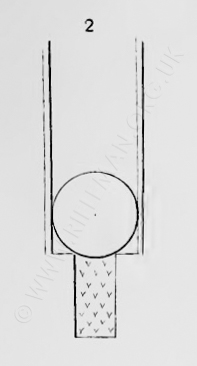 The objection to the chambered rifle, was that after frequently firing, a residuum collected which eventually left the powder less room in the chamber, and of necessity it then reached above the shoulder of the latter, so that the ball resting upon the powder instead of upon the shoulder of the chamber, was not so readily dilated by the strokes of the ramrod into the grooves. To remedy this defect the wooden sabot and greased patch (plate 20, fig. 3)
The objection to the chambered rifle, was that after frequently firing, a residuum collected which eventually left the powder less room in the chamber, and of necessity it then reached above the shoulder of the latter, so that the ball resting upon the powder instead of upon the shoulder of the chamber, was not so readily dilated by the strokes of the ramrod into the grooves. To remedy this defect the wooden sabot and greased patch (plate 20, fig. 3) were suggested by Colonel Poncharra, in 1833, introduced into the French army 1839, and employed in Algeria, 1840, but several inconveniences attended its use.
were suggested by Colonel Poncharra, in 1833, introduced into the French army 1839, and employed in Algeria, 1840, but several inconveniences attended its use.
Colonel Thouvenin endeavoured to overcome these difficulties by fixing at the bottom of the bore an iron shank, around which was placed the powder. This stem, (plate 20, fig. 4)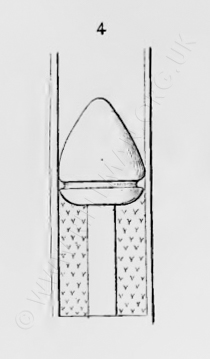 stopping the bullet, allowed it to be struck in such a manner as to cause the lead to penetrate into the grooves. There is much fouling at the breech, and around the pillar of these rifles. They are difficult to clean, the soldier having to carry an instrument for this purpose. The Chasseurs and Zouaves of the African Army were armed with the tige in 1846.
stopping the bullet, allowed it to be struck in such a manner as to cause the lead to penetrate into the grooves. There is much fouling at the breech, and around the pillar of these rifles. They are difficult to clean, the soldier having to carry an instrument for this purpose. The Chasseurs and Zouaves of the African Army were armed with the tige in 1846.
At first a spherical ball had been used, and then a solid cylindro-conical bullet was resorted to ; (Plate 20, fig. 6.) Messrs. Delvigne and Minie having long previously experimented with hollow cylindro-conical projectiles. Some years after these experiments, Captain Minie proposed the adoption of a bullet which should receive its expansion by placing an iron cup in the hollow of the base, which should be driven up by the gas, and. force the walls of the cavity outwards, thus making them enter the grooves. (Plate 20, fig. 7.)
Messrs. Delvigne and Minie having long previously experimented with hollow cylindro-conical projectiles. Some years after these experiments, Captain Minie proposed the adoption of a bullet which should receive its expansion by placing an iron cup in the hollow of the base, which should be driven up by the gas, and. force the walls of the cavity outwards, thus making them enter the grooves. (Plate 20, fig. 7.)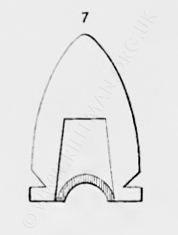 In 1850 the Fusil range with ball culot was put into the hands of some French regiments of the line, and since then the French Imperial Guard have been armed with the old musket rifled, and a hollow bullet without a cup.
At present it is understood that the French are rifling all their smooth bore arms, and the Russians are doing the same.
In 1850 the Fusil range with ball culot was put into the hands of some French regiments of the line, and since then the French Imperial Guard have been armed with the old musket rifled, and a hollow bullet without a cup.
At present it is understood that the French are rifling all their smooth bore arms, and the Russians are doing the same.
The Prussians have many thousands of their infantry armed with a breech-loading long range Rifle. The Russian Army is to have fifty-four rifle regiments, with a rifle company to each other regiment of Infantry. The Austrians are busy at work, according to their means. The Tyrol has always supplied them with a large number of marksmen. The Belgians are, I believe, universally armed with rifles, and even the little Kingdom of Portugal has ordered 28,000 rifles from Belgium.
Subsequent to the French experiments with the conoidal bullet, and the great results obtained over the spherical from it, it was proposed to adapt a conoidal bullet to the Brunswick Rifle. (Plate 20, fig 5.)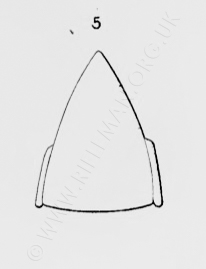 This was done as an experiment, and succeeded very well, but at the same time the new arm, called the Minie pattern, 1851, was also tried, and the shooting exhibited greater accuracy with this latter arm. Nothing further was done with the Brunswick rifle and conoidal bullet ; and the (then called) " new regulation Minie," was introduced into the service by the late Marquis of Anglesea, Master-General of Ordnance, with the approval of the late Duke of Wellington. Its weight with bayonet, was 10 lbs. 81 ozs., bore .702, four spiral grooves, with one turn in 6 feet 6-in., powder, 2.5 drs., bullet, 680 grs., with iron cup, diameter of bullet, .690, windage, •012. When the axis is parallel to the ground at 4 feet 6-in. above it, the first graze is about 177 yards, and the angle of elevation at 800 yards, is 3° 25.
This was done as an experiment, and succeeded very well, but at the same time the new arm, called the Minie pattern, 1851, was also tried, and the shooting exhibited greater accuracy with this latter arm. Nothing further was done with the Brunswick rifle and conoidal bullet ; and the (then called) " new regulation Minie," was introduced into the service by the late Marquis of Anglesea, Master-General of Ordnance, with the approval of the late Duke of Wellington. Its weight with bayonet, was 10 lbs. 81 ozs., bore .702, four spiral grooves, with one turn in 6 feet 6-in., powder, 2.5 drs., bullet, 680 grs., with iron cup, diameter of bullet, .690, windage, •012. When the axis is parallel to the ground at 4 feet 6-in. above it, the first graze is about 177 yards, and the angle of elevation at 800 yards, is 3° 25.
A few years previous to the Russian war, rifles had attained to a degree of improvement in structure and adaptability to the general purpose of war, which threatened subversion to the established notions of the military world. The artillery arm was menaced in its long rested monopoly of range and precision, with an equilibrium in hands it had never dreamed to find it ; one which not alone would curb the wonted dash of field batteries to within the " shortest range," but also impress a more than wonted respect upon the best led and most daring cavalry, for even the thinnest formation of that arm, which it had. hitherto been taught to despise. The Minie was first used in the Kaffir war, and next at Alma and Inkerman, when it proved that the gallant Marquis had advanced a step in the right direction ; who had ordered 28,000, but quarrels taking place among the contractors this order was never completed. The accuracy of firing from the Minie was improved by altering the form of the bullet from conoidal to cylindro-conoidal, (plate 20, fig. 8.) and the iron cup from hemispherical to a conical shape with a hole in the apex.
Lord Hardinge, succeeding to the post of Master-General, and after to that of Com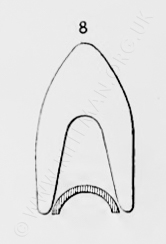 mander-in-Chief, zealously followed out the prosecution of the now becoming fixed idea, the general adoption for British infantry, of a pattern rifle-musket, which should combine lightness with solidity, precision, and superior range. Lord Hardinge opened competition to the leading British gun makers, when the following sent in muskets for trial, viz :—Purdy, Westley Richards, Lancaster, Wilkinson, and Greener. The Minie pattern, (51), and Brunswick, (36), were also subjected to a course of trial before the committee asembled at Enfield, in 1852, for the purpose of determining the best description of fire-arm for military service.
mander-in-Chief, zealously followed out the prosecution of the now becoming fixed idea, the general adoption for British infantry, of a pattern rifle-musket, which should combine lightness with solidity, precision, and superior range. Lord Hardinge opened competition to the leading British gun makers, when the following sent in muskets for trial, viz :—Purdy, Westley Richards, Lancaster, Wilkinson, and Greener. The Minie pattern, (51), and Brunswick, (36), were also subjected to a course of trial before the committee asembled at Enfield, in 1852, for the purpose of determining the best description of fire-arm for military service.
The Brunswick rifle showed itself to be very much inferior in point of range to every arm hitherto tried. The loading was so difficult, that it is wonderful how the rifle regiments can have continued to use it so long, the force required to ram down the ball was so great as to render a man's hand much too unsteady for accurate shooting. Colonel Gordon, says, "It should be noticed here with the exception of Mr. " Wilkinson, every one of the makers changed either his musket or projectile during " the trials, thereby causing them to be protracted much beyond the time originally " intended."
The diameter of the bore of all the new muskets was less than that hitherto in use, all the bullets were elongated and had auxiliaries for expansion, being metallic, or in one case a horn plug, one pattern had cannelures and the whole required the cartridge to be reversed in loading. It is worthy of remark that the best shooting at these trials was from a short rifle made at Enfield, which was named the artillery carbine, but not the one now used by the Royal Artillery. The barrel was only 2 feet 6-in. long, and the projectile cylindro-conoidal, with an iron cup weighing 620 grains ; thus proving that great length of barrel is not absolutely necessary in a rifle ; but a certain length of barrel is required to fire in double ranks, and so that the weapon may be effectually used as a pike. With a small bore, a greater number of rounds of ammunition may be carried, greater penetration, velocity, lower trajectory, and more accuracy, than with larger projectiles of equal weight. The alleged disadvantages of small bore are, the slender form of cartridge and the smaller hole made in a man's body, as stated to be proved in the case of wild animals, in proof of which it is said that they are found to run further when wounded with a small ball, than they do with a large one ; but this reasoning does not seem applicable to the human race, for it is presumed that few men would be found willing to move far when wounded by a musket ball, whether the hole in their body was •702 or .530 of an inch in diameter.
An absurd objection was stated as to reversing the cartridge, viz :—that drill with blank would be performed in a different manner to firing ball, and that in action the soldier would forget to reverse his cartridge, and put in the ball first. As we now always perform our drill, and as our present blank cartridges require to be reversed or will not ignite, this objection is removed. It also was said that mice, rats, &c., &c., would eat off the lubricating mixture ! !
It was proposed to give the Enfield, (1853,) a back sight to 900 yards, when an outcry was raised against the monstrous proposition of giving to every common soldier a delicately made back sight, whether he knew how to use it or not !!! and those rifles first issued, were only sighted to 300 yards.
At the conclusion of the trials at Enfield, in August, 1852, two rifles were made at the Royal Manufactory, in which were embodied the improvements and alterations suggested by the experience obtained during the course of the trials, and which was hoped would possess the necessary requirements for a military weapon, and which proved superior to the Minie, the Brunswick, and all those presented for trial by the different manufacturers.
This beautiful rifle though 2.5 lbs. less than the old musket, is fully as strong, and as capable of rough usage. Weight, including bayonet, 9 lbs. 3 ozs., bore, .577, length of barrel, 3 feet 3-in., weight of barrel, 4 lbs. 4 ozs., three grooves with spiral of one turn in 6 feet 6-in.; the barrel to be fastened to the stock by bands. The bayonet to be fixed by means of a locking ring. The lock to have a swivel. The bullet was of a pattern suggested by Mr. Pritchett. (Plate 20, fig. 9.)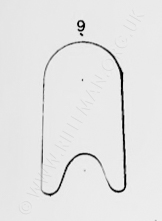
Lord Hardinge, desirous to improve the projectile, and if possible to get rid of the cup, having requested the leading gun makers to lay any suggestions before the small arms committee, none were submitted but one by Mr. Wilkinson, which was not a compound. It was solid with two deep cannelures, but it lost its accuracy when made up into a cartridge, and made very wild practice beyond 300 yards. (Plate 20, fig. 10.) 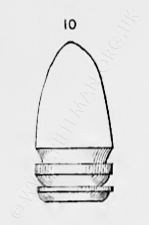 Subsequently a bullet was proposed by Mr. Pritchett, being cylindro-conoidal in form, with a small hollow at the base, which was made more to throw the centre of gravity forward than to obtain expansion thereby. This bullet weighed 520 grains, or 24 guage, and excellent practice was made with it at Enfield, from 100, to 800 yards, and it was accordingly introduced into the service, to the suppression of the Minie, with iron cup ; and for which Mr. Pritchett, received £1,000.
Subsequently a bullet was proposed by Mr. Pritchett, being cylindro-conoidal in form, with a small hollow at the base, which was made more to throw the centre of gravity forward than to obtain expansion thereby. This bullet weighed 520 grains, or 24 guage, and excellent practice was made with it at Enfield, from 100, to 800 yards, and it was accordingly introduced into the service, to the suppression of the Minie, with iron cup ; and for which Mr. Pritchett, received £1,000.
Shortly after the establishment of the School of Musketry, in June, 1853, twenty Enfield rifles were sent down for trial in competition with the Minie, and also with " Lancaster's smooth bore eliptical rifle, with increasing spiral and freed at the breech," when the Enfield was found to be superior to both. It is stated that Mr. Lancaster's invention is intended to overcome the inconvenience attendant on the wearing out the rifle ridges, by the ramrod, &c.; these rifles are also easily cleaned, the difference in width between the major and minor axis of the ellipse was, 1/700 th. of an inch.
Carbines on this principle are now carried by the Royal Engineers, and shoot well, and by some persons are thought to be superior to the Enfield, 1853; they fire the same ammunition, and there is no question but that their firing is much more accurate from using the improved wooden plug bullet. In May, 1855, the ammunition was found to be in a most unsatisfactory state and unfit to be used, there being bullets of various diameters in many of the packages of the cartridges. The correct size of the Pritchett bullet viz., .568, was found to produce accurate shooting, at 600 yards, while bullets of a smaller diameter fired very badly. To get out of this difficulty, Colonel Hay recommended the application of the iron cup to the bullet, which was approved, when more uniform expansion resulted and greater accuracy. Thus by using an auxiliary to expansion there is a margin left to cover any trifling inaccuracy in manufacture, in diameter of either bullet or bore.
The Woolwich authorities stated that they had seven dies at work making bullets, and which were made small at first as they gradually wore larger; when any one die became too large it was destroyed, and replaced by a smaller one. To this cause they imputed the failure of our Pritchett ammunition. It was afterwards suggested from the School of Musketry, to procure expansion by using a wooden plug, and after most extensive experiments, this was found to be superior to any description of bullet yet tried at Hythe, and the wooden plug has accordingly been established for the British army. (Plate 20, fig. 11.)
Uniform accuracy mainly results from the bullet continuing to receive a sufficient and uniform expansion into the grooves, so that the projectiles get such an amount of rotation as shall last until they have reached the object fired at. The more perfect the expansion, the less the accumulation of fouling and consequently accuracy is further increased. The Enfield has frequently been fired to 200 rounds and the loading continued easy.
Early in 1858, the regulation rifle, (53), was changed from grooves of uniform, 014 in depth, to .005 at muzzle, increasing in depth to .015 at the breech ; while new, these rifles shoot well, but they require increased elevation at long ranges. How far these shallow grooves will answer, or how long it will take to convert these arms into smooth bores at the muzzle, by the continued friction of the ramrod, remains to be seen.
Captain Panot, of the French service, states, " it is but a few years since all our "smooth bore barrels were reamed so that they would carry the spherical ball of .669, " instead of .641. It was afterwards determined to convert these arms into rifles. To " prevent weakening the reamed up barrels, M. Tamisier proposed to vary the depth " of the grooves, making them deeper at the breech than at the muzzle." Grooves thus made, are said to have a greater accuracy of fire from keeping the ball perfectly tight as it leaves the bore and destroying all windage at the muzzle. This is called " progressive grooving." Rifles upon this principle require to be fired at an increased elevation, attributed to the greater amount of friction experienced by the bullet while passing down the barrel.
Rifle regiments and all serjeants of infantry have been furnished with a weapon requiring the same. ammunition as the regulation arm, but six inches shorter, being mounted in steel, with a sword bayonet.
A five "grooved progressive" carbine has recently been given to the Royal Marine Artillery and the Royal Navy, with the same bore as the Enfield.
RIFLED BREECH-LOADERS.
It is worthy of notice that, while numerous attempts are now making to perfect the breech-loader for sporting as well as military purposes, our early cannon and first hand guns were loaded at the breech, and if all mechanical difficulties could be overcome, the breech-loading principle for portable fire-arms would deserve the preference.
We can easily understand why it did not continue in favour in early days, as this mode includes a great deal of perfection in mechanical workmanship, and to which the ancient gun maker was a stranger.
The great argument against breech-loaders as military weapons is the expense, their intricate construction, the escape of gas, and the probable waste of ammunition, in the hands of an uneducated soldier. It may be briefly answered.
1st. - As to expense, the most destructive weapon, by preventing and curtailing war, must in the long run be the cheapest.
2nd.—As to intricacy of construction, the soldier is the user, not the maker of his gun ; it matters not how delicate the mechanism of a watch may be, the only question is, does it continue to go well ! ! And who dare say that the brains of man shall never suggest a simple mode of construction. Of course anything fragile would be totally unfit for military purposes. The escape of gas has been entirely overcome.
3rd.—As to waste of ammunition, is it absolutely necessary that a soldier should remain uneducated ? Are not soldiers men ? And men can be taught almost anything, or are they incapable of being taught ? Does a soldier fire how, when and where he chooses ? Is it too high an aspiration that the British army should carry the best arm that can be made, to be placed in the hands of a taught and skilful soldier, acting under the guidance and control of intelligent officers ?
As far as the arm only is concerned, breech-loaders have now (1860) attained a high degree of perfection, as is proved by the deserved celebrity of that made by Mr. Westley Richards. The only remaining difficulty is one of ammunition. Loose powder cannot be employed in loading with a breech as it can with a muzzle-loader. We are up to this time under the necessity of introducing the whole of the cartridge, this of course augments fouling and lessens accuracy ; there is also increased difficulty in producing ignition through the fold of the cartridge paper.
Recently a most ingenious mode of compressing the grains of powder contained in a charge into one mass, so that every description of rifle may be rapidly loaded without any paper, has been invented by Captain Brown, R. N., and I have every hope and confidence that the only remaining breech-loading difficulty may now be considered overcome.
The advantages of breech-loaders, are, 1st. - Celerity of fire, about ten wounds a minute have been attained. 2nd.—The soldier can load while lying flat on the ground. 3rd.—The barrel can be easily cleaned and examined as to its state. 4th.—A solid ball can be fired, and with less windage.
Various modes of self capping have been brought forward, but that by Maynard seems to merit the preference ; time is further economized, and the powers of the breech-loader thereby increased.
Our cavalry regiments in India, are partially armed with breech-loading rifles, and all their pistols are rifled, and upon the tige principle.
The whole of our Guards, regular Infantry, Royal Marines, Militia, and Royal Engineers, are armed with rifles, and the Carabine used by the Royal Artillery, is also rifled. All our Colonial corps are supplied with rifled arms, with the exception of the Native corps, serving in the East Indies and Ceylon.
Thus rifles are introduced in larger numbers and of better quality in the armies of England, in proportion to their numbers, than amongst any other nation. While more care and expense is incurred in qualifying our soldiers efficiently to use them. In illustration of which, it is only needful to call attention to the simple fact that £20,000 per annum is distributed as a stimulus to the marksmen of the British army, for which boon all honour to our Royal Commander-in-Chief.
The idea has recently been revived to increase the destructive powers of Infantry, by furnishing them with shells, with which they may explode ammunition waggons, artillery limbers, &c., &c., to the distance of 1,000 yards. Captain Norton, Mr. Dyer, Colonel Jacobs, and Mr. Whitworth, have directed their minds to this most important subject.
ON RIFLING.
It has been stated that amongst the different gun makers who assembled at Woolwich, for the carrying on of experiments in 1851, no two agreed upon any one thing ; and in 1860, it may still be averred, with almost equal truth, and that it yet remains an unsettled question as to the form, width, depth, number or degree of spirality of the grooves, as also the harmony which should subsist between the grooves, diameter of bore, the form and weight of projectile, and the quality and quantity of charge.
Robins, in 1742, says, " rifles though well known on the continent, being but " little used in England, it is necessary to give a short description of their make. ' The rifle has its cylinder cut with a number of spiral channels, so that it is in reality "a female screw, varying from the fabric of common screws, only in this, that its threads or rifles are less deflected and approach more to a straight line." The advantage of a rifle (with a round bullet), is that the axis of rotation not being in any accidental position, as in a smooth bore, but coincident with the line of its flight, it follows that the resistance on the fore part of the bullet is equally distributed round the centre of gravity, and acts with an equal force on every side of the line of direction, and also should the resistance be greater on one side of the bullet than the other from irregularities on its surface, as this part continually shifts its position round the line in which it is proceeding, the deflections which this irregularity would occasion are neutralized. With an elongated projectile rifling also prevents it from rotating round its shorter axis.
It is to the artizans of Germany, that the rifle owes its origin, as at the close of the fifteenth century barrels with straight grooves were used by the citizens of Leipsic, at target practice, in 1498, and the invention of grooving or rifling fire-arms is generally supposed to be the result more of accident than theory. In Dean's Manual of firearms, it is stated that, " the idea of grooving arms in the direction of the axis of the " barrel to receive the residium of the powder, and thereby, not only facilitate the " loading, but increase both the bite or forcing of the ball, by impressing upon it the " grooves, and thus maintain it during its passage through the barrel in a direction " more in harmony with the line of fire, was doubtless a conception based upon no " previous theory or practice now to be traced, but was formed in that suggestiveness " which in the individual founds for itself a theory based upon the likelihood of " possible result. Upon trial also of the straight grooves a greater precision for " short distances would have been observed than with the smooth bore." This must of itself therefore have led to the establishment of a certain grade of theory which it was endeavoured to amplify by various means, such as increasing the number of grooves, then of changing the inclination of grooves from the straight line to the spiral.
To deem that the practised crack " shots and armourers of a time when target " practice was the constant recreation of the citizen, and his pride to excel in, were so " brainless as to conceive no theory, unelaborated though it may have been, and that " all their even now admired efforts in Germany, were the products of mere accident, is " therefore scarcely a rational supposition."
It is stated that Koster, of Nuremburg, in 1522, first suggested giving a spiral form to the grooves, and experience proved that much greater accuracy of shooting was the result.
In 1552, Darner, of Nuremburg, made some great improvements in rifles, but we are not aware of their precise nature.
Koster, of Nuremburg, who died 1630, by some authorities is said to have discovered that straight grooves did not fulfil the intentions of their inventor, and to have been the first who suggested spiral grooves in 1620.
The important stage next arrived at was the scientific explanation of the true value of spiral grooves. The honor of this entirely belongs to our countryman, Benjamin Robins, who in his Principles of Gunnery, gives a complete and satisfactory explanation of the action of the grooves in determining the flight of the bullet. Robins, states that " the degree of spirality, the number of threads, the depth the "channel are cut down to, are not regulated according to any invariable rule, but " differ according to the country where the work is performed, and the caprice of the " artificer. The most usual mode of charging rifles is by forcing the ball with a strong rammer and mallet. But in some parts of Germany and Switzerland, an improve-ment is made by cutting a piece of very thin leather or fustian in a circular shape, " somewhat larger than the bore, which being greased on one side is laid upon the " muzzle with its greasy part downwards, and the bullet being placed upon it, is then " forced down the barrel with it. When this is practised the rifles are generally "shallow, and. the bullet ought not to be too large.
As both these methods of charging rifles take up a good deal of time ; the rifled " barrels which have been made in England, (for I remember not to have seen it in "any foreign piece,) are contrived to be charged at the breech, where the piece is " made larger, and the powder and bullet are put in through an opening in the side " of the barrel, which, when the piece is loaded is fitted up with a screw. And " perhaps somewhat of this kind, though not in the manner now practised, would " be of all others the most perfect method for the construction of these sorts of " barrels."
ON THE NUMBER, FORM &c., &c., &c., OF THE GROOVES.
Almost every description of twist, number, &c., &c., of grooves have been tried, according to the individual tastes and theories of the manufacturers. It is absolutely necessary to have two grooves, as a single one would give a wrong direction. Rifles have been made with, from two to one hundred and thirty three grooves, and in the majority of cases, an odd seems to have been preferred to an even number. In Dean's Manual it is stated, that " in the numerous collections of arms that have at various times
come under our personal notice, some were rifled with straight, but the " majority with grooves in a spiral line, sometimes with a half, sometimes a three " quarter, and seldom more than a whole turn in a length of two, two and a half and " three feet; deviations based upon no principle transmitted to us, but requiring " nevertheless a decided research for principles upon which to establish a theory ; we " have also met with every one of those configurations of the spiral and form of groove, " &c., &c., which have been arrogated as modern conceits and discoveries."
Some rifles have sharp muzzle twist decreasing to the breech ;—sharp breech twist decreasing to the muzzle ; an increase of twist in the middle of the barrel decreasing at both extremities.
In France a modification of the Carabine took place in 1740 ; —the grooves were made to begin at eight inches from the muzzle, the unrifled part being of the same calibre as the bottom of the grooves, so that the bullet might pass easily ; thus also facilitating the loading of the weapon.
There is an old rifle in the United Service Institution, and also a barrel brought from Lucknow, (in the Model Room of the School of Musketry,) grooved only for about one foot from the muzzle, the remainder of the barrels are smooth bored.
The degree of spirality is found to vary from a whole turn in 1 foot 5-in., to a whole turn in 11 feet.
The depth of grooves vary from .005 of an inch, to about •125; and some rifles have been made with an alternate deep and shallow groove.
Grooves have been made round, circular, triangular, rectangular, and indefinite, alternate round and angular, elliptical, polygonal ; and some cut deep only on one side.
Some gun makers are of opinion that there should be a greater proportion of groove or furrow than of land or plain surface, because they say the ball is thus more firmly held, while others maintain that by diminishing the number of the grooves, the accuracy and range would be increased, and this has led to the opposite theory, that perhaps if anything, the plain surface of the bore should predominate over the grooved.
The earliest rifles had two straight deep creases opposite to each other, the bullet being spherical, and furnished with small circular knots of lead, large enough to fill the creases.
The greater number of ancient rifles have a whole turn, with an odd number of deep and rounded grooves ; hence we may infer these were considered the best forms.
As accuracy of direction n is the result of a spiral motion round an axis coincident with the flight of the bullet, communicated to it by the grooves, it is clear that the depth, number, and form of the grooves should be such as will hold the bullet firmly, and prevent all tendency to strip.
The degree of spirality should be sufficient to retain the projectile point foremost during the whole of its flight. It was at one time supposed that if the spiral turn was great, and the charge strong, the bullet would not conform, but strip, and that the same results would occur even with grooves but little curved. Unquestionably this would prove true if certain limits were to be exceeded. A false conclusion was built upon this theory, viz., that the greater the spiral turn the less the charge should be ; and that therefore in rifles intended for war, the greatest initial velocity being required to produce the greatest range, the groove should have as little turn as possible. For, extreme ranges have been obtained with Jacob's, Whitworth's, and. Lancaster's rifles; the first has a full turn in 24in. the second in 20in. These rifles perform well with 90 grains of powder, and both Whitworth's and Lancaster's might even fire better were the charge of powder increased to 100 grains, the recoil might be objectionable while there would be no symptoms of stripping.
Great depth of groove can only be hurtful, owing to the difficulty of closing up all passage to the gas, which should not be allowed to escape round the bullet, as this would cause deviation and shorten range. Deep grooves become a receptacle for fouling, are difficult to clean; and high projections must offer great resistance to the atmosphere, and particularly to a side wind.
When fustian or leather are used as patches, they receive and communicate the spiral motion to the bullet, without the zone of the projectile being at all indented, but in this case the spiral must be diminished, otherwise the bullet would not turn with the grooves. If the patches be made of a thick material, the grooves should be many, broad, and not too shallow, in order to receive the folds of the patch.
From our present amount of experience it seems safe to conclude that the shallower the grooves are the better, so that they perform their intended functions.
It is now generally recommended that the grooves be made broader than the lands, i.e., that the rifling surface should predominate over the unrifled part of the bore. Shallow grooves with rounded edges, have the advantage of not leaving any angular traces on the surface of the bullet, besides they afford a greater facility for cleaning.
Circular grooving is composed of segments of circles, leaving no sharp edges on the bullet, and is no doubt a very good form.
An American gentleman named Chapman, who has written a very clever book upon the rifle, is a strong advocate for the " gaining twist," which form prevails generally in American rifles. He states, "In a rifled barrel, it is obvious that a bullet "instantaneously started from a state of rest, with a velocity of 5,000ft. a second,
must exert at the moment of starting, a tendency to move along the bore in a " straight line. However, meeting with the resistance that the lands employ to keep " it to the twist, it communicates to the rifle itself a certain amount of motion in the " direction of the twist of the creases, and this as the angle of the twist increases,
combined with the size of the calibre, and the weight of the ball."
" If the angle of the twist at the breech end can be reduced, the bullet at the same time leaving the muzzle with sufficient spin to last throughout its flight, it is certain we shall have less twisting of the rifle in the marksman's hands, less friction " of the bullet against the lands, less tendency for the bullet to upset, (or be des- troyed,) and consequently, from obtaining a higher velocity, (because enabled to use a greater quantity of powder,) less time for' the action of regular or irregular currents of air."
After careful experiments by the American Government, preparatory to the establishing the model for their Military Rifle, it was decided that the turn for the grooves should be uniform ; and that those with an increasing twist did not give any superiority of accuracy. The " gaining twist," although adopted by Mr. Lancaster, is opposed by Mr. Whitworth, and all other Rifle manufacturers, and our increased experience does not prove it to possess any advantages over uniform spirality. Theory would indicate that it must occasion increased friction.
Mr. Greener advocates decreasing spirality. It is to be hoped he is the only advocate for so seemingly absurd an idea. To give a certain measure of spiral turn at the breech, to be withdrawn gradually as the bullet reaches the muzzle, is simply ridiculous, and which, with other conceits previously referred to, it is to be hoped are no more to be repeated.
By the desire of our first Patron, the late Lord Hardinge, Mr. Whitworth was induced to turn his mechanical genius to the Soldier's Gun, which resulted in his adopting the polygonal form of bore. His barrel is hexagonal, and thus, instead of consisting of non-effective lands, and partly of grooves, consists entirely of effective rifling surfaces. The angular corners of the hexagon are always rounded. Supposing a bullet of a cylindrical shape to be fired, when it begins to expand it is driven into the recesses of the hexagon. It thus adapts itself to the curves of the spiral, and the inclined sides of the hexagon offering no direct resistance, expansion is easily effected.
Mr. Westley Richards has followed Mr. Whitworth, by using a polygonal bore, having applied his highly meritorious system of breech-loading to a barrel upon the Whitworth principle, of an octagonal form.
The cardinal feature of this structure is, that the bore of the barrel is smooth, and instead of being circular, is cut into the form of an ellipse, i.e., it has a maj or and minor axis. Upon being expanded by the force of the powder, the bullet is forced into the greater axis of the ellipse, which performs the office of the grooves, rifling the projectile, and imparting to it the spiral or normal movement round its own axis. In 1835 a Captain Berner submitted his elliptical bore musket to the inspection and trial of the Royal Hanoverian Commission, appointed for that purpose, and which gave results so satisfactory, that it was considered admirably adapted for the Jager and Light Infantry Battalions. This principle has been patented by Mr. Lancaster, and the advantages of this form have been previously adverted to.
It is supposed by some persons that if the number of grooves be even, so that they will be opposite to one another, the bullet would then require more force to enlarge it, so as to fill them properly. If the number be unequal, the lands will be opposite to the grooves, and the lead, in forcing, spreading on all sides, will encounter a land opposite to each groove, which will in some measure repel it, and .render its introduction into the opposite groove more complete.
This ingenious theory is set at nought by Whitworth, Jacobs, Lancaster, W.
Richards, &c., &c., who all recommended an even number of grooves, while the Government arms have an odd. number.
If the grooves twist or turn over from left to right, the balls will be carried to the right ; and if from right to left, they will group to the left ; and this result will be great in proportion to the degree of spirality. The causes of Drift or "Derivation" will be treated of hereafter. We know from observation that the majority of balls strike to the right of the mark. The recoil and pulling the trigger throw back the right shoulder, which tend to increase the " derivation" to the right. If the twist were, then, from right to left, the drift, error from pulling, and from recoil, would tend to neutralize each other ; the twist of the grooves should therefore be from right to left, instead of the present universal practice of from left to right.
The barrel of a gun may be looked upon as a machine in which force is generated for the propulsion of the bullet. It is well known that the continued action of a lesser force, will produce a much greater effect, than a greater amount of power applied. suddenly ; hence mild gunpowder is more suitable for rifle shooting than strong, or that which evolves the whole of its gas instantaneously. Time is necessary for the entire combustion of a charge of gunpowder, consequently more mild gunpowder can be fired out of a long, than out of a short barrel, as if fired out of a short barrel, some of the grains might be ejected unconsumed. All extra length, after the last volume of gas is evolved, can only be injurious, by causing loss of velocity from friction. A billiard ball would travel none the further nor straighter, were it to be propelled through a hollow tube, neither would a barrel to a cross bow aid in killing rooks. A barrel favours expansion of the bullet, which is produced by the force of the generated gas, opposed by the column of air in the hollow tube and by the motion of the projectile. Facility in aiming is promoted by the sights being distant from each other. In a military arm a certain length is necessary in order to fire when two deep in the ranks, and length is also advantageous, should the rifle be used as a pike.
The short rifle can be held steadier when standing, by a weak man, and during wind, it is handy when passing through a wood or thicket, and a very short man has more command of his gun when loading ; but with the sword bayonet, it is heavier than the long Enfield and bayonet ; while the sword is very inconvenient when running, firing kneeling, or lying down.
Great substance was at one time considered necessary for accurate firing, it being supposed necessary to prevent vibrations in the barrel ; this is true within certain limits, and the heavier the charge, the heavier the metal ought to be, especially at the breech, but diminishing the thickness, has been proved in no wise to lessen the accuracy. A heavy barrel also lessens recoil, but it would be folly to carry more weight than would neutralize the recoil which could be produced by a greater charge of powder than could be consumed in a given length of barrel.
The two grand requirements of a soldier's gun are, celerity of loading, combined with accuracy at long ranges; and the distance at which he should have the power of firing, should be limited by the strength of his eye. The weight of the projectile being fixed. (.530 grs.), good shooting at extreme distances can only be obtained by reducing the diameter of the bore, which, lessening the frontage of the bullet, causes it to experience less resistance from the air ; it therefore retains a higher degree of velocity than a larger bullet of the same form and weight, and therefore travels further and faster. Gravity has less time to act upon it, in a given distance, and therefore it can be fired at a lower angle, or has what we call a lower trajectory, and its accuracy is increased in direct proportion to the lowness of its flight, all other things being equal.
While the best form, &c., &c., for rifles is not yet determined, there are many points upon which the generality of persons seem more agreed, viz., reduction of bore to about one half-inch in diameter, fewer grooves, shorter barrel, and with increased spirality ; at least, one may safely say that ideas seem to travel in this direction.
ON RIFLE PROJECTILES
We have learned that out of early Artillery were fired bolts, darts, bombs, stones and (more recently) iron shot. From the harquebus and musket : arrows, darts, quarrels, sprites, iron, and lastly leaden spherical balls. Some assert that the idea of lengthened eliptical bullets was enunciated so far back as 1729, and that good results followed their employment, but it is doubtful whether such really did take place.
Leutman, in his "History of St. Petersburgh," says that "it is very profitable " to fire elliptical balls out of rifled arms, particularly when they are made to enter " by force."
Robins, in 1742, recommended the use of projectiles of an egg like form, (see plate 20, fig. 12), they were to be fired with the heavy end in front,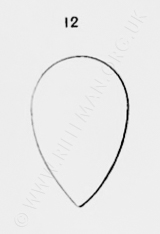 to keep the centre of gravity forward.
to keep the centre of gravity forward.
Colonel Beaufoy, in a work called " Scloppetaria," 1812, remarks that several experiments have been tried with egg-shaped bullets, recommended by Robins. It was found, however, that these bullets were subject to such occasional random ranges, as completely baffled the judgment of the shooters to counteract their irregularity. Their deviations to windward most likely arose from the effect of the wind on the after part, which, as being the lightest of the two, was driven more to leeward, and consequently acted as a rudder to throw the foremost end up to the wind.
In 1770 Messrs. Turpin tried elongated bullets, at La Fiere, and at Metz.
We are informed, in the Annual Register for 1776, and also in the Scots Magazine for the same year, that rifled Ordnance were experimented with at Languard. Fort, &c., &c., in 1774. Dr. Lind, one of the inventors, states that to remedy the deflection of shot, " One way is to use bullets that are not round but oblong. But in "our common guns that are not rifled, I know no way to prevent deflection, except "you choose to shoot with a rifled bullet."
Elongated Projectiles were tried in the years 2, 6, and 9 of the Revolution, by Mons. Guitton de Moreau. They were proposed by Mons. Bodeau. In 1800 and 1815 the Prussians tried ellipsodical bullets. Colonel Miller, Colonel Carron, Captain Blois, and others, also experimented with the cylindro-conical form.
Captain Norton (late 34th Regt.), the original inventor of the application of the percussion principle to shells for small arms, in 1824, completed an elongated rifle shot and shell, the former precisely of the form of the Minie bullet, with projections to fit the grooves of the barrel.
Mr. Greener, in 1836, presented an expanding bullet to the Government for experiment, (plate 20, fig. 13). It is oval, with a flat end, an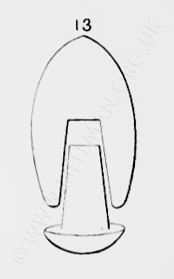 d with a perforation extending nearly through. A taper plug, with a head like a round-topped button, is also cast of a composition of lead and zinc. The end of the plug being slightly inserted in the perforation, the ball is inserted either end foremost. When the explosion takes place, the plug is driven home into the lead, expanding the outer surface, and thus either filling up the grooves of the rifle, or destroying the windage of the musket. The result was favourable beyond calculation. Of about 120 shots by way of experiment, a man was able to load three times to one of the old musket, and. accuracy of range at 350 yards was as three to one.
d with a perforation extending nearly through. A taper plug, with a head like a round-topped button, is also cast of a composition of lead and zinc. The end of the plug being slightly inserted in the perforation, the ball is inserted either end foremost. When the explosion takes place, the plug is driven home into the lead, expanding the outer surface, and thus either filling up the grooves of the rifle, or destroying the windage of the musket. The result was favourable beyond calculation. Of about 120 shots by way of experiment, a man was able to load three times to one of the old musket, and. accuracy of range at 350 yards was as three to one.
Mr. Greener's invention was rejected, and the only notice lie received from the Board was, it being " a compound," rendered it objectionable ! ! !
The following extract appears in the Estimates of Army Service for 1857-8. " To William Greener, for the first Public Suggestion of the principle of expansion, "commonly called the Minie principle for bullets in 1836, £1,000."
Many experiments were made by Mr. Wilkinson in 1837, with balls precisely similar in shape to the Minie, with a conical hole in them, using a wooden plug ; and in 1851 experiments were tried at Woolwich with a soft elastic cork, fitting the aperture in the projectile very closely, the compression of which it was conceived would sufficiently expand the cylindrical part, and make it fit the grooves, &c. In sonic instances it succeeded perfectly, but in many the cork was driven through the lead.
Major-General Jacobs for many years carried on a series of experiments with rifles, and in 1846 submitted a military rifle, with an elongated projectile, for experiments, to the Government at home, and also to that in India. It did not meet with approval in England, and the Company cut the matter short by stating, that what was good enough for the Royal Army was good enough for theirs. There is nothing peculiar in General Jacob's rifle. He recommends an elongated projectile (plate 20, fig. 14) solid at the base, cast with four raised flanges to fit into the grooves. General Jacobs states, that the desired initial velocity could not be produced with a projectile made entirely of lead, as a slight increase of charge had the effect of destroying the form of the projectile. He also states that the limit of the powers of leaden ball shaving been attained, it became necessary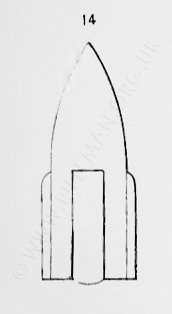 to find a method of constructing rifle balls, so that the fore part should be capable of sustaining the pressure of large charges of fired gunpowder, without change of form, and retain that shape best adapted for overcoming the resistance of the air, on which all accurate distant practice depends ; and at the same time having the part of the ball next the powder sufficiently soft and yielding to spread. out under its pressure, so as to fill the barrel and grooves perfectly
air tight. And he professes to have solved the problem, by having the fore part of the bullet cast of zinc, in a separate mould.
to find a method of constructing rifle balls, so that the fore part should be capable of sustaining the pressure of large charges of fired gunpowder, without change of form, and retain that shape best adapted for overcoming the resistance of the air, on which all accurate distant practice depends ; and at the same time having the part of the ball next the powder sufficiently soft and yielding to spread. out under its pressure, so as to fill the barrel and grooves perfectly
air tight. And he professes to have solved the problem, by having the fore part of the bullet cast of zinc, in a separate mould.
Captain Delvigne, who had been experimenting since 1828, proposed the
adoption of lengthened bullets, consisting of a cylinder terminated by a cone, which
was subsequently replaced by an ogive. He obtained a patent dated 21st June, 1841,"For having hollowed out the base of my cylindro-conical bullet, to obtain its expansion by the effect of the gases produced through the ignition of the powder."
The main object of Captain Delvigne in hollowing the base was, to throw the
centre of gravity forward ; but a Captain Blois, in France, had previously tried this
important suggestion. Captain Delvigne states, if the hollow is too deep, the
expansion is too great, and the consequent friction enormous ; or the gas may pass through the bullet, and leave a hollow cylinder of lead within the barrel. Sometimes the gas will traverse the sides of the bullet, and consequently the projectile is deprived of a proportionary amount of velocity; if too small, the expansion does not take place.
Captain Minie, an instructor of the School at Vincennes, merely fitted into this
hollow an iron cup, hoping to prevent the gas forcing its way through the bullet, and that the iron pressing upon the lead should increase the expansion. (Plate 20, fig. 7).
A perfect bullet was now supposed to have been discovered, of a cylindro-ogival form, (no part was a true cylinder), having a  groove originally intended to fasten on a greased patch, and in some cases the cartridge, but the patch being dispensed with,
and the cartridge reserved, the groove, supposed to be useless, was suppressed.
groove originally intended to fasten on a greased patch, and in some cases the cartridge, but the patch being dispensed with,
and the cartridge reserved, the groove, supposed to be useless, was suppressed.
People were then surprised to find that firing lost much of its accuracy, and the groove was replaced; when it was observed that any variation in its shape and in its position, materially affected the practice. Not only variations in the grooves caused great alteration in the accuracy of fire, but any modification bearing on the trunk in
rear, or on the fore-ogive, altered the conditions of the firing, so that the groove became lost in the midst of so many other principles, the functions of which were so much unknown. These theoretical considerations served, however, as a point of departure for further investigations.
Captain Tamisier had not ceased for several years, concentrating his attention on
the subject. He varied the length of the cylindrical part and the angle of the cone,
and tried experiments with bullets of 5-in. in length, and obtained considerable range, and great accuracy with them ; the recoil however was excessive, and to use such bullets heavier arms, a smaller bore, and other modifications would be necessary.
He endeavoured to carry the centre of gravity to the furthest possible point forward, (which Robins suggested 100 years before), but to effect this he was compelled to flatten the fore end of the bullet, which had the disadvantage of increasing the resistance of the air to the movement of projection.
He was then led to another plan for rectifying the path of the bullet through each instant of projection, and which was by creating at the posterior end, resistances,
which should act in case the axis of the bullet did not coincide with the direction of
motion, and this was carried out by cutting upon the cylindrical part, instead of one, as many circular grooves of .28 in depth, as that cylindrical, or rather, slightly conical, part could contain. An increased precision in firing was the immediate result. (Plate 20, fig 15.)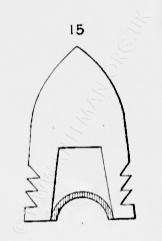
Feeling his way most carefully, Captain Tamisier then made a great number of experiments in this direction, and perceived that it was important to render the posterior surface of the grooves as sharp as possible, so as to augment the action of the air ; for these grooves lose their shape, owing to the lead, from its malleable nature, yielding under the strokes of the ramrod.
Elongated projectiles, whose centres of gravity do not exactly coincide with the centre of figure, when they do not turn over, tend to preserve their axis in the primary direction which was imparted to them, in the same manner as an imperfectly feathered arrow flying with littl e velocity, the point of the moving body being constantly above the trajectory, and its axis making a certain angle (plate 21, fig 1) with the target to the curve.
e velocity, the point of the moving body being constantly above the trajectory, and its axis making a certain angle (plate 21, fig 1) with the target to the curve.
Therefore the part A.B. of the bullet being exposed to the direct action of the air's resistance, the atmospherical fluid. is compressed on the surface A.B., and rarified upon that of A.C. Hence it will be perceived that the compressed fluid supports the moving body, and prevents its descending as rapidly as would a spherical bullet, which is constructed to meet the same direct resistance from the air. This trajectory will therefore be more elongated than that of the spherical bullet in question.
But the resistance of the air, acting upon the groove of the projectile, produces, on the lower part of this groove, an action which tends to bring back its point upon the trajectory, yet with so little force, that often, in its descent, the projectile turns over, and moves breadthways at ranges of 1000 and 1200 yards. The lower side of the projectile, therefore, moving in the compressed air, and the upper in the rarified air, deviation must ensue, for, as the upper part of the bullet moves from left to right, the bottom must move from right to left. But the lower resistance to the motion of rotation being produced by the friction of the compressed air, is greater than the upper resistance, which depends on the friction of the rarified air. By combining these two resistances, there results a single force, acting from left to right, which produces what Captain Tamisier termed " derivation," and it was to overcome this derivation that this officer proposed the circular grooves to the bullet, which he considered would act, like the feathers of the arrow, to maintain the moving body in its trajectory.
If, however, we would wish to obtain some idea of the rotatory motion of a bullet in its path through the air, let us consider the action of the arrow, and see how it is constructed, so that the resistance of the air should not act in an unfavourable manner. First, nearly all its weight is concentrated at the point, so that its centre of gravity is close to A. At the opposite end feathers are placed, the heaviest of which does not affect the centre of gravity, but gives rise to an amount of resistance in rear of the projectile, and which prevents its ever taking a motion of rotation perpendicular to its longer axis, and keeps it in the direction of its projection. This difficulty which the arrow finds in changing its direction must concur in preventing its descending so rapidly as it would do were it only to obey the law of gravity, and must therefore render its trajectory more uniform.
Let us, however, now come back to the grooves of Mons. Tamisier, and we shall find that they concur in giving to the bullet the two actions of the resistance of the air, which we have demonstrated with respect to the arrow.
Suppose that such a bullet describes the trajectory m, and A.B. be the position of its axis, it will be seen that the lower part of the bullet re-establishes the air compressed, whilst the upper part finds itself in the rarified air. That, consequently the lower parts of the cannelures are submitted to the direct action of the air's resistance, whilst their upper parts totally escape this action. (Plate 21, fig. 2).

The resultant of the air's resistance evidently tends to bring back the point of the moving body, according to the trajectory; but as this action is produced by the pressure of an elastic fluid, it results that the point B, after having been an instant upon the trajectory, will fall below, in virtue of the velocity acquired; but then the upper grooves finding themselves acted on by the action of the air's resistance, this action, joined to its weight, will force the point of the projectile upwards, which will descend to come up again, so that the projectile will have throughout its flight a vertical swing, which is seen distinctly enough in arrows.
Let us connect the suggestion of Robins, with the experiments of Captain Tamisier, to cause the posterior end to act as a rudder to guide the projectile in its true path, as undoubtedly during the descent of a bullet there is a tendency for the centre of gravity to fall first, as the ball of the shuttlecock. In the first Prussian balls, and in those used in the Tige, the centre of gravity being nearer the base, the rear end of these balls have a tendency to fall before the foremost, but this is most undoubtedly counteracted by grooves, while it would be impossible to fire an elongated projectile with its centre of gravity backwards, with any accuracy out of a smooth-bored gun.
Captain Jervis says that these grooves have the effect of improving the accuracy of firing when the bullets are not perfectly homogeneous, is certain, but the British Committee on small arms justly considered that owing to the careful way ha which the bullets are made in England by compression, these grooves might be dispensed with.
Almost every conceivable form of projectile, internal and external, have been made and experimented upon. Auxiliaries to expansion have been used, made of metal, horn-wood, and leather, with plugs, screws, or cups divers shapes. Cannelures are used, of varying forms, depth and number.
It has even been attempted to construct bullets upon the screw principle, so that the projectile should receive spirality from the action of the air upon its outer or inner surface, when fired out of a smooth bore musket.
The general characteristics of the European rifles, up to 1850, are a very large calibre, a comparatively light short barrel, with a quick twist, i.e., about one turn in three feet, sometimes using a patch, and sometimes not, the bullet circular, and its front part flattened by starting and ramming down.
It appears that the introduction of additional weight in the barrel, reduction in the size of the calibre, the constant use of the patch, a slower twist, generally one turn in 6ft., combined with (what is now known to be a detriment) great length of barrel, are exclusively American.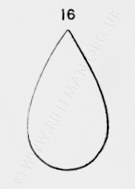
A round ended picket (plate 20, fig. 16),
was occasionally used in some parts of the States, until the invention of Mr. Allen Clarke, of the flat ended picket, which allows a much greater charge of powder, producing greater velocity, and consequently less variation in a side wind.
A rifle may perform first rate at short ranges, and fail entirely at long, while a rifle which will fire well at extreme ranges can never fail of good shooting at short. In fact certain calibres, &c., &c., &c., perform best at certain distances, and in the combinations of a perfect rifle there are certain points to be attended to, or the weapon will be deficient and inferior.
It is desirable to give a bullet as much velocity as it can safely be started with, and the limit is the recoil of the gun, and the liability of the bullets to be upset or destroyed, for as soon as this upsetting takes place, the performance becomes inferior, and the circle of error enlarged.
It is clear that a bullet projected with sufficient twist to keep it steady in boisterous and windy weather, must of necessity have more twist than is actually necessary in a still favourable time; hence a rifle for general purposes, should always have too much twist rather than too little.
The weight of the bullet must be proportioned to the distance it is intended to be projected with the greatest accuracy; for it is a law, that with bodies of the same densities, small ones lose their momentum sooner than large ones. It would be madness to use a bullet ninety to the pound at nine hundred yards, merely because it performed first rate at two hundred yards; or a forty to the pound at two hundred yards, because it performed well at nine hundred yards. The reason is that a forty to the pound cannot be projected with as much velocity at two hundred yards, as the ninety to the pound can, because the ninety uses more powder in proportion to the weight of the bullet than the forty does. Again, the heavier bullet performs better than the lighter one at nine hundred yards, simply because the momentum of the light ball is nearly expended at so long a range as nine hundred yards, and its rotatory motion is not enough to keep it in the true line of its flight, whereas a heavy bullet, having from its weight more momentum, preserves for a longer distance the twist and velocity with which it started.
As weight of projectile is a leading element in obtaining accuracy at long ranges, and as the weight cannot be increased beyond a certain limit in small arm ammunition, hence a small bore is an indispensable requisite for a perfect rifle.
In the foregoing brief summary of the most important properties which should be possessed by a first class rifle, we have dealt in generalities, but we shall now record the experience of Mr. Whitworth, who has entered into the most minute details, and has pointed out the harmony which should subsist between the twist, bore, &c., and the projectile, in the combinations of a perfect rifle.
Premising, that when Mr. Whitworth was solicited by the late honored Lord Hardinge to render the aid of his mechanical genius to the improvement or perfecting a military weapon, he was restricted as to length of barrel, viz., 3 feet 3-in., and weight of bullet, 530 grains. We shall now proceed and use Mr. W Whitworth's words.
" Having noticed the form (hexagonal) of the interior which provides the best " rifling surfaces, the next thing to be considered is the proper curve which rifled " barrels ought to possess, in order to give the projectile the necessary degree of rotation."
" With the hexagonal barrel, I use much quicker turn and can fire projectiles of " any required length, as with the quickest that may be desirable they do not strip.' " I made a short barrel with one turn in the inch (simply to try the effect of an extreme
velocity of rotation) and found that I could fire from it mechanically—fitting projec-" tiles made of an alloy of lead and tin, with a charge of 35 grains of powder they "penetrated through seven inches of elm planks."
After many experiments, in order to determine the diameter for the bore and degree of spirality, Mr. Whitworth adds : "For an ordinary military barrel, 39 inches "long, I proposed a .45-inch bore, with one turn in 20 inches, which is in my opinion " the best for this length. The rotation is sufficient with a bullet of the requisite " specific gravity, for a range of 2000 yards." Under these conditions the projectiles on leaving the gun would be about two and a half diameters of the bore in length. " The gun responds to every increase of charge, by firing with lower elevation, from " the service charge of 70 grains up to 120 grains; this latter charge is the largest "that can be effectively consumed, and the recoil then becomes more than the shoulder "can conveniently bear with the weight of the service musket.
" The advocates of the slow turn of one in 6 feet 6 inches, consider that a quick " turn causes so much friction as to impede the progress of the ball to an injurious " and sometimes dangerous degree, and to produce loss of elevation and range ; but "my experiments show the contrary to be the case. The effect of too quick a turn, " as to friction, is felt in the greatest degree when the projectile has attained its "highest velocity in the barrel, that is at the muzzle, and is felt in the least degree " when the projectile is beginning to move, at the breech. The great strain put upon " a gun at the instant of explosion is due, not to the resistance of friction, but to the "vis inertiae of the projectile which has to be overcome. In a long barrel, with an " extremely quick turn, the resistance offered to the progress of the projectile is very " great at the muzzle, and although moderate charges give good results, the rifle will " not respond to increased charges by giving a better elevation. If the barrel be cut "shorter, an increase of charge then lowers the elevation."
" The use of an increasing or varying turn is obviously injurious, for besides " altering the shape of the bullet, it causes increased resistance at the muzzle, the very " place where relief is wanted."
"Finding that all difficulty arising from length of projectiles, is overcome by " giving sufficient rotation, and that any weight that may be necessary can be obtained " by adding to the length, I adopted for the bullet of the service weight, an increased " length, and a reduced diameter, and obtained a comparatively low trajectory ; less " elevation is required, and the path of the projectile lies more nearly in a straight " line, making it more likely to hit any object of moderate height within range, and "rendering mistakes in judging distances of less moment. The time of flight being "shortened, the projectile is very much less deflected by the action of the wind."
"It is most important to observe that with all expanding bullets proper powder "must be employed. In many cases this kind of bullet has failed, owing to the use of " a slowly igniting powder, which is desirable for a hard metal projectile, as it causes "less strain upon the piece, but is unsuitable with a soft metal expanding projectile, "for which a quickly igniting powder is absolutely requisite to insure a complete "expansion, which will fill the bore. Unless this is done the gases rush past the "bullet between it and the barrel, the latter becomes foul, the bullet is distorted, and " the shooting must be bad. If the projectiles used be made of the same hexagonal " shape externally as the bore of the barrel internally, that is, with a mechanical fit, "metals of all degrees of hardness, from lead, or lead and tin, up to hardened steel "may be employed, and slowly igniting powder, like that of the service may be " employed."
Mr. 'Whitworth does not lay claim to any originality as inventor of the polygonal system, but merely brings it forward, as the most certain mode of securing spiral motion, but he deserves to be honored by all Riflemen, as having established the degree of spirality, the diameter of bore, to ensure the best results from a given weight of lead, and length of barrel.
CONCLUSION.
In achieving the important position obtained by the rifle in the present day, it has nevertheless effected no more than was predicted of it by Leutman,. the Academician of St. Petersburg, in 1728, by Euler, Borda, and Gassendi, and by our eminent but hitherto forgotten countryman Robins, who in 1747, urgently called the attention of the Government and the public to the importance of this description of fire-arm as a military weapon.
In the War of American Independence, the rifle, there long established as the national arm for the chase, exhibited its superiority as a war arm also, in so sensible a manner, that we were constrained to oppose to the American hunters the subsidised Riflemen of Hesse, Hanover, and Denmark.
We shall close by quoting the last words in "Robins' Tracts of Gunnery."
" Whatever State shall thoroughly comprehend the nature and advantages of rifled " barrel pieces, and having facilitated and completed their construction, shall introduce " into their armies their general use with a dexterity in the management of them ; they " will by this means acquire a superiority, which will almost equal anything that has "been done at any time by the particular excellence of any one kind of arms ; and "will perhaps fall but little short of the wonderful effects which histories relate to "have been formerly produced by the first inventors of fire-arms."
NOTE.—The preceding articles on the Rifle, Rifling, and Rifle Projectiles are mainly compiled from : "New Principles of Gunnery, by Robins," "Scloppetaria," "Remarks on National Defence, by Col. the Hon. A. Gordon," "Dean's Manual of Fire Arms," "Rifle Ammunition, by Capt. A. Hawes," "Rifles and Rifle Practice, by C. M. Wilcox," " Papers on Mechanical Subjects, by Whitworth," " The Rifle Musket, by Capt. Jarvis, Royal Artillery," "Des Armes Rayees, by H. Mangeot," "Cours Elementaire sur les Armes Portatives, by F. Gillion," and "fours sur les Armes a feu Portatives, by L. Panot."
The whole Plates 20 & 21 are shown below.
Click or hover over each image to view in high resolution
PLATE 20
PLATE I
The entire book can be viewed here
Click images to bring up hi-resolution file and magnifier
